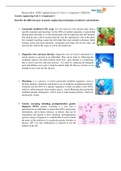Moreen Mero - BTEC Applied Science L3 Unit 11 Assignment 4 2020/2021
Genetic engineering Unit 11 Assignment 4
Describe the different types of genetic engineering technologies in industry and medicine:
1. Genetically modified (GM) crops: It is the removal of the desired gene from a
specific organism and inserting it in the DNA of another organism, to spread that
desired gene and make it, so the desired gene will be expressed and will increase.
The desired gene will be inserted directly into the reproductive cell of the plant.
For example, inserting a gene that will make that crop resistant to diseases, better
looking, tastier and more nutritious, sustainable and longer life for the crops, and
increase the yield of the crops as well as the health rate.
2. Diagnostic tests and gene therapy: diagnostic tests are used to determine if a
certain disease is present in an individual. This can be done by following the
symptoms reports, and other medical result tests. gene therapy is a technology
that is used to prevent, and treat diseases. It is done by replacing the damaged
gene and adding a new gene to help the patient fight the disease, and also as an
attempt to treat, and cure the disease.
3. Pharming: it is a process, in which genetically modified organisms, such as
bacteria, produce substances and drugs to use in medicine and pharmaceuticals.
Scientists use the DNA of a specific organism, so they can splice a new DNA;
which is called transgene from another species. And in Pharming; the genetically
modified animals (transgenic), will be used to make human proteins, which are
medicinally valued.
4. Genetic screening including preimplantation genetic
diagnosis (PGD): genetic screening is a test, that is
performed on an individual, to check their DNA and genetic
information, and to detect diseases, or defects, that can be
transmitted and passed to their offspring. preimplantation
genetic testing or diagnosis is a method that is used to check
the genes of the embryos for a particular genetic disorder or
disease. IVF ( In-vitro fertilization) is required to test the
embryo in the lab.
, Moreen Mero - BTEC Applied Science L3 Unit 11 Assignment 4 2020/2021
5. Stem cell therapies, e.g. Parkinson’s disease,
macular degeneration, spinal cord injuries:
stem cells are differentiated cells of an ongoing
source, that make up the organs and the tissues
of plants and animals. Stem cells contribute to
the therapy development; to replace damaged
cells that are a result of certain diseases and
disorders. Moreover, stem cell therapies are used
to treat and prevent diseases, such as Parkinson’s
disease; which is a disorder in the central
nervous system, which results from social
behavioural disorders. Stem cell therapy can
provide treatment for Parkinson’s disease, and it
helps to control the disease. Currently, there are no developed stem cell treatments for
Parkinson’s disease, as it has been unsure of the harms that it might cause. other therapies;
Umbilical cord stem cells: which are found in the umbilical cord blood, are retrieved after
delivery and are used to treat rare genetic disorders, and also blood cancer.
6. Xenotransplantation: this is a transplantation of a
living organ, cells and tissues from nonhuman
species, to human patients, or from one species to
another. For example; xenotransplantation in medical
research targets transplanting organs(hearts, kidneys
or livers) from pigs, into humans. Therefore, this will
be used as a treatment for some diseases, such as liver
failure, Parkinson's cell therapy, diabetes therapy and
so. Xenotransplantation raises the challenges in the
bioethical issues, such as animal experiments, public
health issues, and also transgenic animals.




